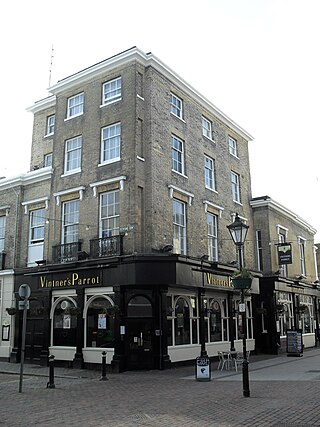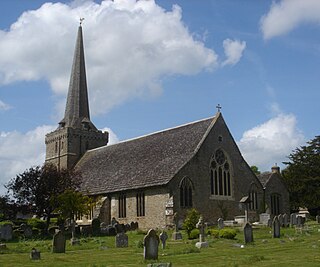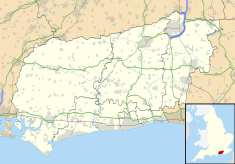
West Sussex is a ceremonial county in South East England. It is bordered by Surrey to the north, East Sussex to the east, the English Channel to the south, and Hampshire to the west. The largest settlement is Crawley, and the county town is the city of Chichester.

Chichester is a cathedral city and civil parish in West Sussex, England. It is the only city in West Sussex and is its county town. It was a Roman and Anglo-Saxon settlement and a major market town from those times through Norman and medieval times to the present day. It is the seat of the Church of England Diocese of Chichester, with a 12th-century cathedral.

Marquess of Donegall is a title in the Peerage of Ireland held by the head of the Chichester family, originally from Devon, England. Sir John Chichester sat as a Member of Parliament and was High Sheriff of Devon in 1557. One of his sons, Sir Arthur Chichester, was Lord Deputy of Ireland from 1605 to 1616. In 1613, he was raised to the Peerage of Ireland as Baron Chichester, of Belfast in County Antrim. He died childless in 1625 when the barony became extinct.

Midhurst is a market town, parish and civil parish in West Sussex, England. It lies on the River Rother 20 miles (32 km) inland from the English Channel, and 12 miles (19 km) north of the county town of Chichester.

There have been four baronetcies created for persons with the surname Miller, two in the Baronetage of England, one in the Baronetage of Great Britain and one in the Baronetage of the United Kingdom. Two of the creations are extant as of 2008.

Westhampnett is a village, Anglican parish and civil parish in the district of Chichester in West Sussex, England, located 1 mile (1.6 km) northeast of Chichester on the former A27 road, now by-passed. The village is pre-Norman and is home to many listed buildings, including the Saxon church of St Peter, where three bishops of Chichester are buried. The parish of Westhampnett includes most of Goodwood estate, its golf course, motor-racing circuit and airfield.

West Sussex County Council is the upper tier local authority for the non-metropolitan county of West Sussex in England.

The Ancient Priors is a medieval timber-framed hall house on the High Street in Crawley, a town and borough in West Sussex, England. It was built in approximately 1450, partly replacing an older structure—although part of this survives behind the present street frontage. It has been expanded, altered and renovated many times since, and fell into such disrepair by the 1930s that demolition was considered. It has since been refurbished and is now a restaurant, although it has been put to various uses during its existence. Secret rooms, whose purpose has never been confirmed for certain, were discovered in the 19th century. English Heritage has listed the building at Grade II* for its architectural and historical importance, and it has been described as Crawley's "most prestigious medieval building" and "the finest timber-framed house between London and Brighton".

The Thieves' Kitchen is a pub in the centre of the town and borough of Worthing, West Sussex. Established as a public house in the late 20th century, it occupies two early 19th-century listed buildings in the oldest part of the town: a Greek Revival-style former wine merchants premises, and a Neoclassical chapel built for Wesleyan Methodists in 1839. The main part of the pub is in the wine merchants building facing Warwick Street, while the old chapel, facing Bedford Row, serves as its function room. Both buildings have been designated separately as Grade II Listed Buildings.

Patcham Place is a mansion in the ancient village of Patcham, now part of the English city of Brighton and Hove. Built in 1558 as part of the Patcham Place estate, it was owned for many years by Anthony Stapley, one of the signatories of King Charles I's death warrant. It was extended and almost completely rebuilt in 1764, with traces of the older buildings remaining behind the Classical façade with its expanses of black glazed mathematical tiles—a feature typical of Brighton buildings of the era. Contemporary uses have included a youth hostel, but the house is currently used as a commercial premises. English Heritage has listed it at Grade II* for its architectural and historical importance.

Holy Trinity Church is an Anglican church in the village of Cuckfield in the district of Mid Sussex; one of seven local government districts in the English county of West Sussex. It was founded in the 11th century and was in the possession of Lewes Priory by 1090. The present structure dates from the mid-13th century but was extended in the 14th century and heavily altered and restored during the Victorian period, with much interior work by Charles Eamer Kempe and stained glass by both Kempe and the Clayton and Bell firm. The church's spire was replaced in 1981 following a fire. Former chapels of ease in outlying hamlets have closed, and the church now serves a large rural area in the centre of Sussex. It is protected as a Grade I listed building.

Ebenezer Particular Baptist Chapel is a former Strict Baptist place of worship in Hastings, East Sussex, England. Founded in 1817 by members of the congregation of an older Baptist chapel in the ancient town, it was extended several times in the 19th century as attendances grew during Hastings' period of rapid growth as a seaside resort. It was closed and converted into a house in the late 20th century, but still stands in a prominent position in Hastings Old Town. English Heritage has listed the building at Grade II for its architectural and historical importance.

Madina Mosque is a mosque in the centre of Horsham, an ancient market town in the English county of West Sussex. It has served the Muslim community of the town and the surrounding district of Horsham since 2008. The plain stuccoed building in which it is housed was originally a Baptist chapel—one of several in the town, which has a long history of Nonconformist Christian worship. The former Jireh Independent Chapel was in commercial use until Muslims acquired it after a lengthy search for a permanent space. The organization, 'Muslims in Britain' classify the Madina Mosque as, "Deobandi".
Clayton & Black were a firm of architects and surveyors from Brighton, part of the English city of Brighton and Hove. In a career spanning the Victorian, Edwardian and interwar eras, they were responsible for designing and constructing an eclectic range of buildings in the growing town of Brighton and its neighbour Hove. Their work encompassed new residential, commercial, industrial and civic buildings, shopping arcades, churches, schools, cinemas and pubs, and alterations to hotels and other buildings. Later reconstituted as Clayton, Black & Daviel, the company designed some churches in the postwar period.

All Souls Church is a former Anglican church that served the Clive Vale suburb of Hastings, a seaside resort town and borough in the English county of East Sussex, between 1890 and 2007. The "large [and] serious town church" has been described as one of the best works by prolific ecclesiastical architect Arthur Blomfield. Built almost wholly of brick, inside and out, it dominates the streetscape of the late Victorian suburb and has a tall, "dramatic" interior displaying many of Blomfield's favourite architectural features. The church also has Heaton, Butler and Bayne stained glass and an elaborate reredos. Falling attendances and high maintenance costs caused it to close after a final service in November 2007, and the Diocese of Chichester officially declared it redundant soon afterwards. English Heritage has listed it at Grade II* for its architectural and historical importance.

Little Durnford Manor is a Grade I-listed country house in Durnford, Wiltshire, England, about 3 miles (4.8 km) northeast of the city of Salisbury. The current house was built in the late 17th century and remodelled for Edward Younge, a friend of Lord Pembroke, around 1720–1740.

County Hall is a municipal facility at West Street in Chichester, West Sussex. It is the headquarters of West Sussex County Council.

The Council House is a municipal building in North Street, Chichester, West Sussex, England. It is a Grade II* listed building.

British Queen Anne Revival architecture, also known as Domestic Revival, is a style of building using red brick, white woodwork, and an eclectic mixture of decorative features, that became popular in the 1870s, both for houses and for larger buildings such as offices, hotels, and town halls. It was popularised by Norman Shaw (1831–1912) and George Devey (1820–1886).

Sandown Town Hall is a municipal building in Grafton Street, Sandown, Isle of Wight, England. The structure, which was the meeting place of Sandown Urban District Council, is a Grade II listed building.




















